圣经中“诺亚”的后裔-希纳里克镇居民
编辑:给力英语新闻 更新:2017年12月29日 作者:丹尼尔·莫里茨-拉布森(Daniel Moritz-Rabson)
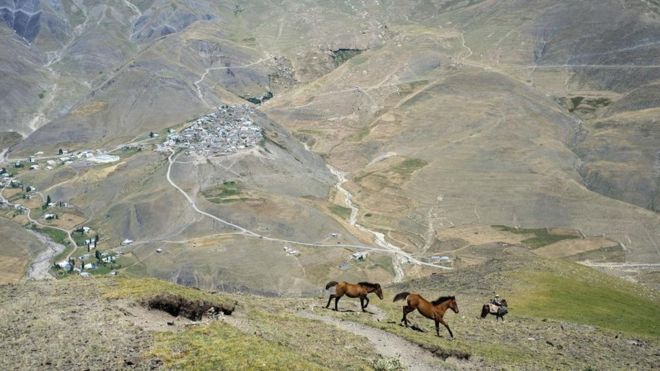
The descendants of 'biblical Noah'
阿塞拜疆海拔最高的小镇
Azerbaijan’s highest town
阿塞拜疆海拔最高的小镇希纳里克(Khinaliq)位于大高加索山脉深处,悠久的民间传说为这里蒙上了一层神秘的面纱。考古和历史研究表明,当地居民的祖先早在大约2,000年前就迁徙到了这里。而有些采访过这里的新闻记者甚至认为,这里居民的先祖可以追溯到5,000年前的阿尔巴尼亚高加索时期。当地流传的神话故事则把这里的居民称作是圣经里诺亚的后代。
Nestled in the Greater Caucasus mountains, Azerbaijan’s highest town of Khinaliq is swirled in mystery and folklore. Archaeological and historical studies indicate that the population’s ancestors moved to the town’s current location around 2,000 years ago. Certain journalists covering the region, however, have conjectured that locals can trace their ancestry back 5,000 years to the Albanian Caucus period. And a local legend names the residents as living descendants of "biblical Noah". (Credit: Oleksandr Rupeta/Getty Images)
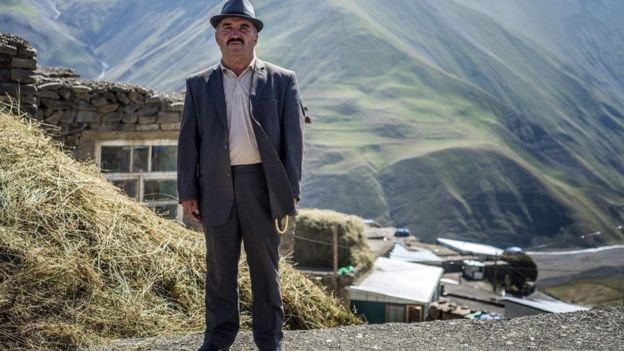
与世隔绝的多彩地区
Isolation and diversity
这座小镇位于阿塞拜疆东北部以多样化的文化和民族特色而著称的库巴区(Quba)。山地犹太人、塔特人(Tats)和列兹金人(Lezgins)聚居区分布于大高加索山脉的缓坡地带,而希纳里克小镇则位于海拔更高的地方。这里的所有山地群落都对他们的独特文化而备感自豪。
The town is located in Azerbaijan’s Quba district, a northeastern region of rich cultural and ethnic diversity. Distinct ethnic communities of Mountain Jews, Tats and Lezgins reside on the mountains’ lower slopes, with Khinalig perched above. All the mountain communities pride themselves on their identities. (Credit: Oleksandr Rupeta/Getty Images)

独树一帜
Stand alone
"他们告诉我,'我们不是阿塞拜疆人',"Getty图片社摄影师奥莱克斯坦德.卢佩塔(Oleksandr Rupeta)说。他曾经在今年9月参加库巴区民族多样性纪录片摄制组并走访了希纳里克小镇。
“They told us ‘we are not Azerbaijani’,” said Getty photographer Oleksandr Rupeta, who visited Khinaliq in September as part of a project documenting the ethnic diversity in Quba. (Credit: Oleksandr Rupeta/Getty Images)
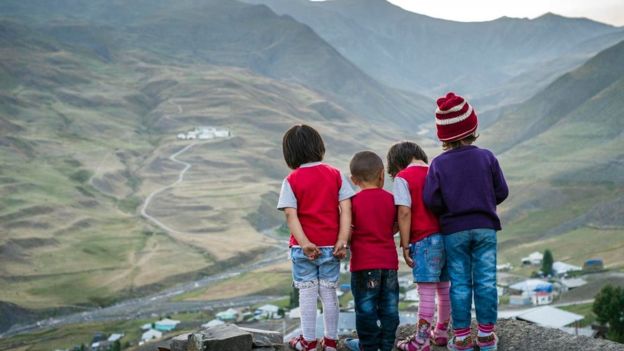
儿童, 希纳里克(Khinaliq), Khinalug, 山脉 (图片来源: OleksandrRupeta/Getty Images)
独特的语言
Linguistically unique
这里通行的希纳里克语只为少量本地居民所使用,因此联合国教科文组织将其列为极度濒危语言。
Here, the local language is Khinalug, which is exclusive to the area. But Unesco has labelled it severely endangered as only the small number of Khinaliq residents speak it.
然而,希纳里克语依然有望继续生存下去。希纳里克的中学有300多名本地学生,授课语言包括希纳里克语、阿塞拜疆语和英语。
However, the language still has hope for survival. Khinaliq’s secondary school – attended by more than 300 local children – offers lessons in Khinalug alongside Azerbaijani and English. (Credit: Oleksandr Rupeta/Getty Images)
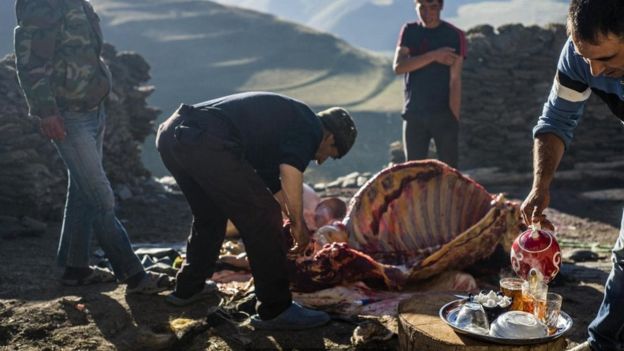
悠久的历史传统
Longstanding traditions
希纳里克的婚礼仪式严格遵循从远古时期一直流传下来的传统:新娘一家会剥掉一具牛尸的皮然后割下牛肉,同时为宾客上茶。
The wedding rituals in Khinaliq are strictly mandated by standards passed down through the generations. To commemorate a marriage, the family of the bride flays a bull carcass, stripping the meat. Tea is served during the process.
"喝茶也是仪式的一部分," 卢佩塔说。"在他们的传统文化里,这是一件很重要的事情。"
“Drinking tea [is] like a ritual,” Rupeta said. “It's very important in their culture.” (Credit: Oleksandr Rupeta/Getty Images)
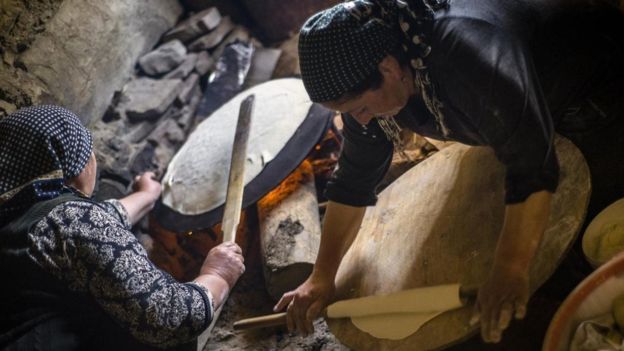
食物种类匮乏
A constrained diet
在这座位于高海拔地带的小镇,很多农作物难以培养。因此,当地人只得种植土豆等主食作物。他们的食谱里只有为数不多的几种普通谷物。小镇居民日常食用的是在高加索地区和整个西亚都很常见的亚美尼亚扁面包。这种扁面包是用一种特制平底锅在灶火上烤制而成,小镇上的妇女可以在短短两个小时内就烤好足够一个星期食用的扁面包。
The town’s extreme elevation prevents the successful cultivation of many crops. As such, locals grow staples, such as potatoes, and subsist on a simple diet that incorporates a number of simple grains. Townsfolk boast of their unique recipe for lavash, a flatbread commonly found throughout the Caucasus region and Western Asia. It’s baked over fire using a special pan, and the townswomen can prepare a week’s supply in two hours. (Credit: Oleksandr Rupeta/Getty Images)
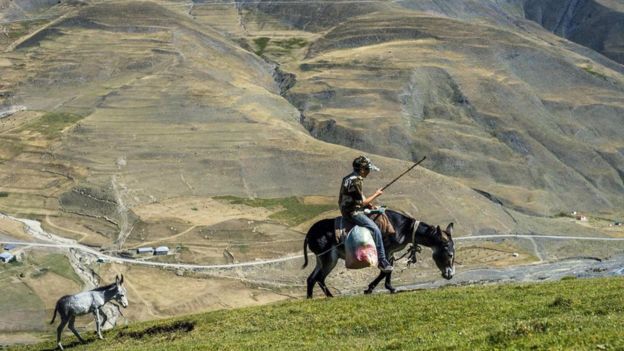
对外开放
Opening up
然而,这里数千年的与世隔绝所造就的独特文化正在越来越多地受到现代社会的威胁。2006年,连接库巴区首府库巴和希纳里克小镇的公路竣工,使这座小镇终于和外面的世界联系在了一起。从那时起,造访这里的游客越来越多。
But these traditions, developed over millennia of isolation, are being threatened by increasing modernization. In 2006, the completion of a road between Quba, the region’s capital, and Khinaliq finally connected the town to the world, and more visitors are starting to trickle in. (Credit: Oleksandr Rupeta/Getty Images)
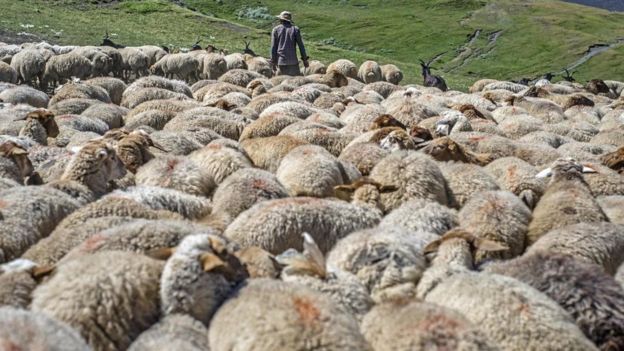
气候恶劣
Driven by a harsh climate
尽管对外公路已经开通,但在一年中大多数时间里,这条公路却无法通行。每年9月这里就开始降雪,冬天气温会降至-21℃。酷寒的天气不仅隔绝了公路交通,还迫使牧人(畜牧业是这里的经济支柱)们把牲畜赶到低海拔的温暖地带以安全过冬。
Nevertheless, despite the new route, accessibility remains impossible for much of the year. Snow often begins to fall in the area as early as September, and winter temperatures have been known to drop as low as -21C. The stark weather not only blocks the road, but forces shepherds, who form the economic backbone of the community, to relocate their livestock to lower, warmer areas. (Credit: Oleksandr Rupeta/Getty Images)
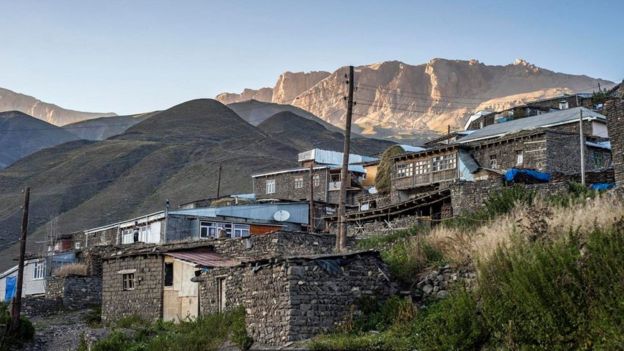
丰富的自然资源
A resourceful community
小镇居民在冬天燃烧一种由牲畜粪便和黏土混合而成的燃料"tezek"取暖,房屋则是由在附近古代尔河(Gudyal River)开采的石料建造而成;有些房屋已经矗立了200年之久并经历了多起地震而不倒。
绵羊是希纳里克小镇生产生活的核心,小镇的食物、衣物以及与临近城镇的贸易都依赖于它。正是这里丰富的自然资源才让这座小镇在天高路远的山区高地自我维持了上千年的漫长岁月。
Without gas, the townsfolk burn tezek, a compacted mixture of manure and hay, for warmth. Their homes are built from stones from the nearby Gudyal River; some of them have stood for 200 years and through countless earthquakes. And sheep remain a central part of the lifestyle in Khinaliq, providing food, clothing and trade with other towns. It’s this resourcefulness that has enabled this community to survive for centuries high up in the mountains. (Credit: Oleksandr Rupeta/Getty Images) Editor's note: The original article incorrectly stated that the town has no electricity. This has now been corrected.